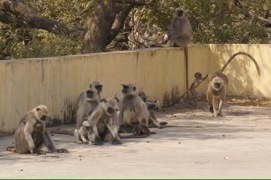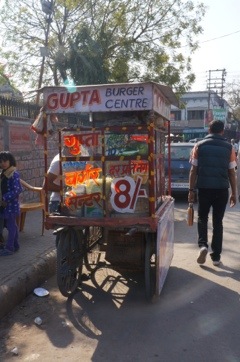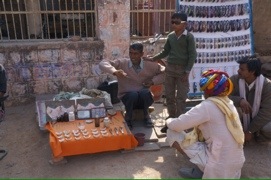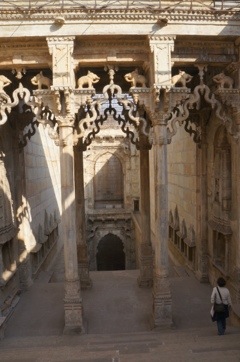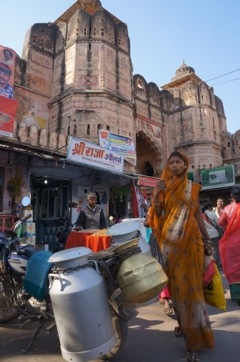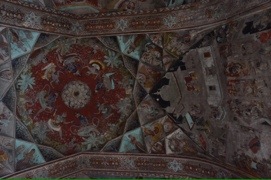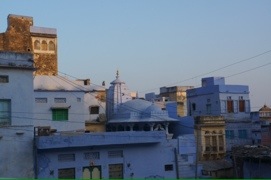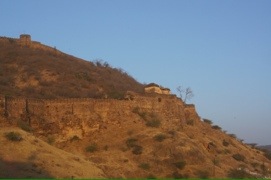My next destination is Bundi, a small 12th century town in Southern Rajasthan, where Rudyard Kipling once stayed, and was said to have been inspired to begin “Kim”.
The little bus takes us across the desert, through plains and ravines, and through tiny villages with colourful murals painted on whitewashed walls. We stop near a deserted lake to stretch our legs, and as if by magic a man appears with a kettle and a cardboard box, to set up an impromptu chai stand and sweet stall. In the high season Intrepid passes through here once a week, so I’m sure he knew we were coming, but after the drive it is a welcome surprise all the same.
In Bundi, our hotel was a British guest house during the Raj, with such luminaries as Lord Mountbatten on the guest list. These days it’s a humbler crowd, but the hotel retains a quaint charm, with high ceilings, impossibly high wooden beds and an assortment of curios in the dining room that ranges from a stuffed tiger’s head to an 1880s panorama of London to a pair of dolls with a terrifying stare, which look as though they could come alive at any moment.
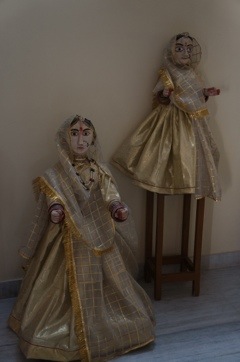 Extras from latest series of Dr Who
Extras from latest series of Dr Who
The roof has been colonised by a family of langurs, who allow us to share their space until the ratio of human to monkey is exceeded and, threatened, they bare their teeth and chase us back to the stairs.
The hotel is just on the edge of town, a 15 minute amble to the old town where Bundi’s few tourists usually stay. Joghi, our host, takes us on a walking tour of his town. The main street into town is lined with market stalls selling fruit, vegetables, sugarcane juice and other standard items, but closer to town there is a more unusual trade.
The street dentists have their wares laid out, false teeth and filthy instruments (with a sideline in cheap sunglasses, for reasons known only to themselves). At one, an elderly man is having a tooth extracted. Small brown bottles of liquid opium sit ready to numb the pain.
It’s all a bit much for our own resident dentist, who is utterly horrified, and refuses point blank to touch the instruments, which bear clear signs of their previous subjects. Can’t say I was keen, either.
Moving away from the gory marketplace, we make our way towards one of the sites for which Bundi is best known, a large stepwell called the Raniji Ki Baori, built by the then-queen in 1699. There were once around fifty step wells (“baori”) in Bundi, though many are now disused or covered over. The Rani ji ki baori is supposed to be the most beautiful. It is decorated with elaborate carving combining Hindu and Jain features. There is a barrier part way down the steps to the well, so it’s no longer possible to descend to the water, which is visible far below from a small bridge. In its day this would have been a hive of activity as local royalty came to sit near the cool water and escape the summer heat.
From the stepwell we turn back towards the old town and wind our way through the marketplace, past locksmiths and spicesellers, through the main gate and up the steep hill towards the fort.
The gate of the fort is high enough to accommodate elephants. The building, once so magnificent that Kipling described it as “such a palace as men have built for themselves in uneasy dreams… the work of goblins rather than of men”, has been allowed to decline and disintegrate. Care is needed on the steps (look out for the giant wild beesnest over the gate). In some alcoves there are remnants of wall paintings, along with local graffiti. Up another narrow flight of stairs, we come to a room richly decorated with murals depicting women and men at play during Holi, and even an Indian angel or two.
From the courtyard of the former womens’ quarters there are sweeping views over the city, and the lake below.
Across the courtyard is a hidden room, which is unlocked as long as we promise not to take photos (and a couple of attendants watch closely to ensure we comply). Inside, every inch is covered in the most exquisite miniature paintings, save for a few gaps where gold leaf and decoration has been ripped from the wall by thieves. It’s the most amazing and unexpected sight amid the ruin of the building.
Outside I stop to take a few photos of the houses along the street, which are all painted blue – Jodhpur is known as the Blue City, but parts of Bundi are just as picturesque – well, except for the inescapable tangles of electrical cables….
Walking back through the town I notice that there are barely any touts – one street with guesthouses aimed at tourists, a few touristy shops, but the parts of Bundi that I have seen on this whistle-stop tour seem remarkably untouched.
